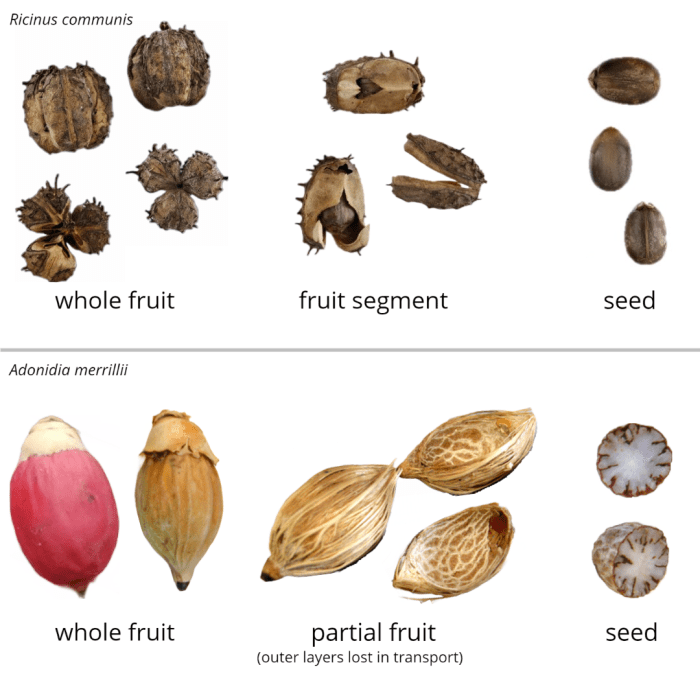Do All Seed Plants Produce Fruit?
Do All Seed Plants Produce Fruit?
Do all seed plants produce fruit – The question of whether all seed plants produce fruit hinges on a precise understanding of what constitutes “fruit” in a botanical context. Common usage often differs significantly from the scientific definition, leading to confusion. This article will explore the botanical definition of fruit, examine the reproductive strategies of seed plants (gymnosperms and angiosperms), and analyze the diverse forms fruit can take.
Botanical Definition of Fruit

Source: idtools.org
In botany, a fruit is a mature ovary of a flowering plant, containing one or more seeds. This definition is far more inclusive than the common understanding of fruit as a sweet, edible entity. Many structures we wouldn’t typically consider fruits, based on their taste or texture, are indeed fruits according to this definition. For instance, tomatoes, cucumbers, and even acorns are botanically classified as fruits because they develop from the ovary of a flower and contain seeds.
Fruit development begins with pollination and fertilization of the flower’s ovules. Following fertilization, the ovary wall, known as the pericarp, develops into the fruit itself. The pericarp can be fleshy, dry, or a combination of both, contributing to the diverse array of fruit structures we observe.
Seed Plant Classification and Reproduction
Seed plants are broadly categorized into two major groups: gymnosperms and angiosperms. Gymnosperms, meaning “naked seeds,” have seeds that are not enclosed within an ovary. Angiosperms, on the other hand, are flowering plants whose seeds develop within an ovary, which later matures into a fruit. This fundamental difference in seed development significantly influences their reproductive strategies.
Gymnosperms typically reproduce using cones, with male cones producing pollen and female cones bearing ovules. Pollination occurs when pollen is transferred to the ovules, leading to fertilization and seed development. Angiosperms, with their more complex flowers, utilize a wider range of pollination mechanisms, including wind, water, and animals. Double fertilization is a hallmark of angiosperm reproduction, resulting in both the embryo and the endosperm, the nutritive tissue for the developing embryo.
Gymnosperm Reproduction and “Fruit”
Gymnosperms, including conifers like pines and spruces, reproduce via cones. The female cone contains ovules, which, after fertilization, develop into seeds. These seeds are not enclosed within a fruit; instead, they are typically exposed on the surface of the cone scales. Therefore, gymnosperms are not considered to produce fruit in the botanical sense, as the ovule doesn’t develop within a mature ovary.
| Characteristic | Gymnosperms | Angiosperms |
|---|---|---|
| Reproductive Structure | Cones | Flowers |
| Seed Development | Seeds exposed on cone scales | Seeds enclosed within a fruit |
| Seed Dispersal | Wind, gravity | Wind, water, animals |
Angiosperm Reproduction and Fruit Diversity

Source: scientificamerican.com
Angiosperms exhibit an astonishing diversity of fruit types, each reflecting adaptations for seed dispersal. Some common examples include berries (tomatoes, grapes), drupes (cherries, peaches), nuts (acorns, walnuts), and legumes (peas, beans). The structure of the fruit often directly relates to its method of seed dispersal.
| Fruit Type | Description | Examples | Seed Dispersal |
|---|---|---|---|
| Berry | Fleshy fruit with multiple seeds | Tomato, grape, blueberry | Animals |
| Drupe | Fleshy fruit with a hard inner layer surrounding a single seed | Peach, cherry, plum | Animals |
| Nut | Hard-shelled fruit with a single seed | Acorn, walnut, hazelnut | Animals, gravity |
| Legume | Dry fruit that splits open along two seams | Pea, bean, soybean | Animals, gravity |
Exceptions and Special Cases

Source: fruitonix.com
While most angiosperms produce fruits, exceptions exist. Some plants have modified or unusual fruit structures. For example, certain species might have fruits that are indehiscent (do not open at maturity) or have structures that aid in specialized dispersal mechanisms.
- Parthenocarpic fruits: Fruits that develop without fertilization, resulting in seedless varieties like seedless bananas or watermelons. These fruits are still botanically considered fruits due to their development from an ovary.
- Multiple fruits: Fruits formed from the fusion of many individual fruits from a single inflorescence, such as pineapples and figs. These demonstrate a unique adaptation to resource utilization and seed dispersal.
- Aggregate fruits: Fruits that develop from multiple ovaries of a single flower, like raspberries and strawberries. Each “drupelet” on a raspberry represents a single ovary.
Seed Dispersal Mechanisms and Fruit Structure, Do all seed plants produce fruit
The relationship between fruit structure and seed dispersal is intimate. Fruits adapted for wind dispersal are often lightweight and have wings or plumes (e.g., dandelion seeds). Fruits dispersed by water are typically buoyant (e.g., coconuts). Fruits dispersed by animals often have fleshy, attractive features (e.g., berries) or hooks or barbs that attach to fur (e.g., burrs).
Example 1: A winged samara (like a maple seed) utilizes wind dispersal; its wing-like structure allows it to be carried by the wind over long distances.
Example 2: A coconut, with its buoyant husk, is adapted for water dispersal; ocean currents can transport it across vast stretches of water.
Example 3: A fleshy berry, with its sweet and colorful flesh, attracts animals; animals consume the fruit and disperse the seeds in their droppings.
Helpful Answers: Do All Seed Plants Produce Fruit
What is the difference between a botanical fruit and a culinary fruit?
A botanical fruit develops from the flower’s ovary after fertilization. A culinary fruit is a sweet, edible fruit commonly consumed, but this definition doesn’t align strictly with botanical classifications (e.g., tomatoes are botanical fruits, but often considered vegetables culinarily).
Do all angiosperms produce fruits?
While most angiosperms produce fruits, there are exceptions. Some species may have modified or reduced fruit structures due to evolutionary adaptations.
What are some examples of fruits that aren’t considered fruits in everyday language?
Tomatoes, cucumbers, and peppers are all botanical fruits but are often used as vegetables in cooking.
Not all seed plants produce what we typically consider “fruit.” The definition of fruit is actually quite specific, relating to the development of the plant’s ovary. However, considering the broader question of seed dispersal, you might wonder about propagation methods like planting seeds, such as when determining if can you plant iris seeds in the spring.
This highlights that even without a fleshy fruit, many plants successfully propagate through seed dispersal mechanisms. Therefore, the presence or absence of a “fruit” is not the defining factor in seed plant reproduction.
How do fruit structures aid in seed dispersal?
Fruit structures are adapted to various dispersal methods. Fleshy fruits attract animals for dispersal, while dry fruits may rely on wind or water.





















